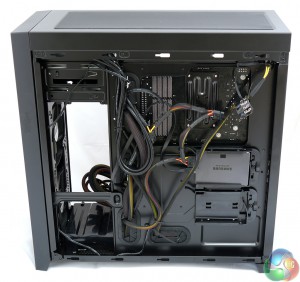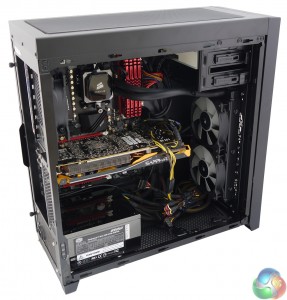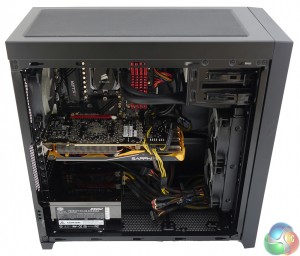



Here is a quick series of photos of the outside of the PC once it was built that show the case with the grilles removed from the bottom, top and front of the case.


I want to drive home the point that the 450D has been designed with airflow in mind but is also a cinch to keep clean as the front grille pops off and the top and bottom dust covers are held in place with magnets.



With the side panel removed you can see the ASRock 990FX Killer motherboard, AMD FX-8350 processor, four modules of G.Skill Ripjaws X RAM, Sapphire Radeon Tri-X R9 290 4GB graphics card and Noctua NH-U12S air cooler vanish inside without any problem. The Obsidian 450D is ‘limited' to using a CPU cooler that is 165mm in height. I use inverted commas as that isn't really a limitation at all.
The only fly in the ointment is that I grabbed an 850W Coolermaster PSU from the shelf that has fixed cables instead of using a modular design. This wasn't a conscious decision on my part, it just so happened the Coolermaster was the first PSU that came to hand. I knew I would have to hide the cables but as you can see from the photos this wasn't as easy as I had hoped.

I built this system using a single Samsung 500GB 840 EVO SSD that went in a drive bay on the back of the motherboard tray which meant that I could remove the plastic 3.5-inch drive tower.
Removing the drive tower is a simple matter of undoing two screws and pulling the tower out. This freed up a fair amount of space for the PSU cables, however I would have done better to use a modular design.


So why didn't I feed the cables through those rubber grommets and hide them behind the motherboard tray? I tried, honestly I did, but there isn't enough space. In fact that is only part of the story as the grommets are prone to pulling out of place and the location of the cable holes isn't too great. In particular I found the eight-pin EPS cable was a stretch as there is very little leeway with routing of the PSU cables.

My overwhelming impression of the back of the built system is that it is all perforations and holes that add up to heaps of airflow.






Corsair makes a feature of the options for radiator mounts in the Obsidian 450D. Mounting a radiator up to 360mm in the roof of the case looks straightforward however I have my doubts about mounting a 240mm radiator at the bottom. I'm not quite sure why that would be desirable and am quite sure you'd need to use a compact and modular PSU to create as much space as possible. Clearly it would be a simple matter to substitute a 120mm radiator for the 120mm exhaust fan at the rear.
I was more interested in the claims about installing a 240mm or 280mm radiator at the front of the case. I had already removed the drive tower but that was only the start. Before I could install the 240mm Corsair H100i radiator I had to remove the plastic mount for the 3.5-inch drive tower as it fouled the end tank of the radiator so I laid the case on its back, popped off the bottom magnetic grille and removed four screws.
It looked like a simple job to remove the two front 140mm fans. I popped off the front mesh panels and removed the screws at the corners of the fans and that looked like the end of the job. Except that the block connectors for the fans didn't have the room to slip free at the front so I could pull the fans forward to the extent of the cabling but couldn't fully remove them from the case.
This forced me to unclip the drive bay bezel and then remove the two revealed screws. Then I could unlatch the front panel of the case (which includes the two front feet) and finally the front of the case was exposed.


As you can see in the photos there are mounts for two 120mm fans or two 140mm fans and you can indeed install a 240mm radiator such as the Corsair H100i. It is worth spelling out that the exhaust points to the front as KitGuru is a firm believer in expelling hot air.
The finished installation was nice and tidy and shows the Obsidian 450D does indeed offer a number of choices for system cooling.
 KitGuru KitGuru.net – Tech News | Hardware News | Hardware Reviews | IOS | Mobile | Gaming | Graphics Cards
KitGuru KitGuru.net – Tech News | Hardware News | Hardware Reviews | IOS | Mobile | Gaming | Graphics Cards




